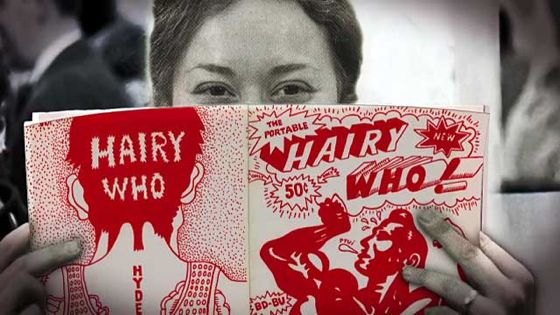Hairy Who & the Chicago Imagists
A Film About the Chicago Art Movement That Offended Almost Everyone
Do you remember your first look at the so-called Chicago Imagists in art galleries in the ’60s and ’70s? Whether you were on your own or in a stroller pushed by your parents, you surely found the art of the “Hairy Who” to be eye-popping, colorful, vulgar and fun.
You can relive those artistic memories in Hairy Who & the Chicago Imagists, a lavishly illustrated new film documentary that illuminates the lively and confrontational art movement that started here in the 1960s. Director Leslie Buchbinder combines film of the young artists and interviews with many of them in their later years. Other interviews are with the 21st century artists they influenced, such as Jeff Coons, Peter Doig and Chris Ware, as well as collectors and curators. Best of all, we see many of the actual works–vibrant, vivid and surreal paintings and objects. The production also features great animation work and original music.
The film illustrates how the Hairy Who/Chicago Imagist movement evolved from the first group of artists that included Gladys Nilsson, Jim Nutt, Art Green, Karl Wirsum and Jim Falconer to later groups of artists also under the Hairy Who/Chicago Imagist rubric. “The Nonplussed Some,” “False Image” and “Marriage Chicago Style” included artists like Ed Paschke, Roger Brown, Ed Flood, Sarah Canright, Cristina Ramberg and Philip Hanson. Art Institute professor Ray Yoshida also was an influence and a participant.
Some of the famous Hairy Who images were Wirsum’s vivid portraits of musicians like Howlin’ Wolf, Junior Wells and Screaming Jay Hawkins; Nutt’s cigar-chomping, amputated women; Paschke’s garish portraits of women inspired by posters outside strip clubs; and Ramberg’s studies of corsetry and bondage.
You can view a selection of art and watch the film trailer here.
The Hyde Park Art Center and director Don Baum are credited with giving the art movement its first visibility in group exhibits starting in 1966. Art critic Franz Schulze gave the exhibit a positive review, commenting that the artists were “embracing pop culture in its most vulgar form.” At the time, other critics used words like pugnacious, puerile, scatological, comical and absurd. How could we not love art that so offended the establishment?
The movement was a cousin to the pop art movement that grew in New York. The film makes the point that New York art tended to be more impersonal, large scale and abstract. Cool, that is, where this Chicago art was subjective, personal–and hot.
Unlike some other art movements of the time, Chicago Imagist art did not sell out for commercial purposes. As underground artist Gary Panter said, “Everything that was invented in the ’60s could be co-opted, immediately. There was no problem co-opting Op Art, Hippie Art, anything. But the Hairy Who couldn’t be co-opted. It had embraced insanity and psychosis. And you don’t sell toothbrushes with that.”
The 105-minute film is written by John Corbett and narrated by Chicago actor Cheryl Lynn Bruce, with animations and titles by Lilli Carre, motion graphics by Julius Dobiesz and sound design by Alex Inglizian. The original score for cello and voice was composed by Tomeka Reid. The producer is Chicago’s Pentimenti Productions, a nonprofit founded by Buchbinder.
Hairy Who & the Chicago Imagists was shown this month at the Museum of Contemporary Art and Block Cinema at Northwestern University. Hairy Who has had limited showings in a few other cities and at film festivals and will have a one-week run at the Gene Siskel Film Center in late September. For more information about the film, visit pentimentiproductions.org/
Related note: See Slowdown on the opening of the Ed Paschke Art Center in Jefferson Park on Sunday, June 22.





